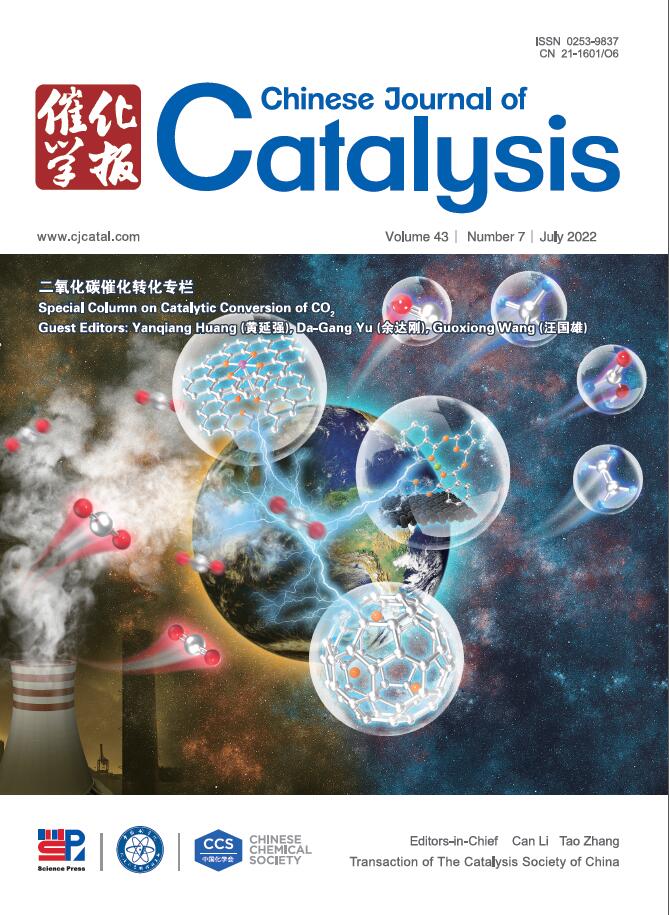Boosting photocatalytic water oxidation via interfacial electric field-mediated charge separation in S-scheme photocatalyst
IF 17.7
1区 化学
Q1 CHEMISTRY, APPLIED
引用次数: 0
Abstract
The major challenge in photocatalytic water splitting lies in water oxidation reactions, which still suffer from poor charge separation. This study overcame inefficient charge separation by establishing a robust interfacial electric field through the electrostatic-driven assembly of Co3O4 nanoparticles with a perylene imide supramolecule (PDINH). The well-aligned band structures and intimate interfacial contact in the PDINH/Co3O4 heterostructure create an enhanced interfacial electric field that is 4.1- and 53.2-fold stronger than those of individual PDINH and Co3O4, thus promoting directional charge separation and transfer. Moreover, S-scheme charge transfer strongly preserves the oxidative holes in PDINH to drive efficient water oxidation reactions. Consequently, PDINH/Co3O4 composite achieves a photocatalytic oxygen evolution rate of 29.26 mmol g–1 h–1 under visible light irradiation, 8.2-fold improvement over pristine PDINH, with an apparent quantum yield of 6.66% at 420 nm. This study provides fundamental insights into interfacial electric field control for the development of high-performance organic photocatalysts for efficient water oxidation.
s型光催化剂中界面电场介导的电荷分离促进光催化水氧化
光催化水分解技术面临的主要挑战在于水氧化反应,而水氧化反应仍然存在电荷分离不良的问题。本研究通过静电驱动Co3O4纳米颗粒与苝酰亚胺超分子(PDINH)的组装,建立了一个强大的界面电场,克服了低效的电荷分离。PDINH/Co3O4异质结构中排列良好的能带结构和密切的界面接触产生了增强的界面电场,比单独的PDINH和Co3O4强4.1倍和53.2倍,从而促进了定向电荷的分离和转移。此外,S-scheme电荷转移强烈地保留了PDINH中的氧化空穴,从而驱动了高效的水氧化反应。因此,PDINH/Co3O4复合材料在可见光下的光催化析氧速率为29.26 mmol g-1 h-1,比原始PDINH提高了8.2倍,在420 nm处的表观量子产率为6.66%。该研究为开发高效水氧化的高性能有机光催化剂提供了界面电场控制的基础见解。
本文章由计算机程序翻译,如有差异,请以英文原文为准。
求助全文
约1分钟内获得全文
求助全文
来源期刊

Chinese Journal of Catalysis
工程技术-工程:化工
CiteScore
25.80
自引率
10.30%
发文量
235
审稿时长
1.2 months
期刊介绍:
The journal covers a broad scope, encompassing new trends in catalysis for applications in energy production, environmental protection, and the preparation of materials, petroleum chemicals, and fine chemicals. It explores the scientific foundation for preparing and activating catalysts of commercial interest, emphasizing representative models.The focus includes spectroscopic methods for structural characterization, especially in situ techniques, as well as new theoretical methods with practical impact in catalysis and catalytic reactions.The journal delves into the relationship between homogeneous and heterogeneous catalysis and includes theoretical studies on the structure and reactivity of catalysts.Additionally, contributions on photocatalysis, biocatalysis, surface science, and catalysis-related chemical kinetics are welcomed.
 求助内容:
求助内容: 应助结果提醒方式:
应助结果提醒方式:


